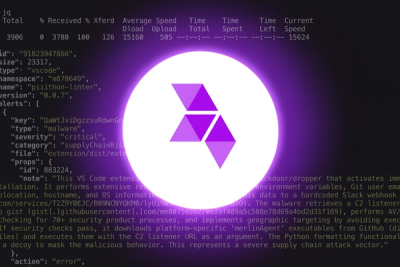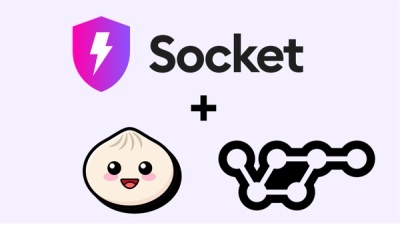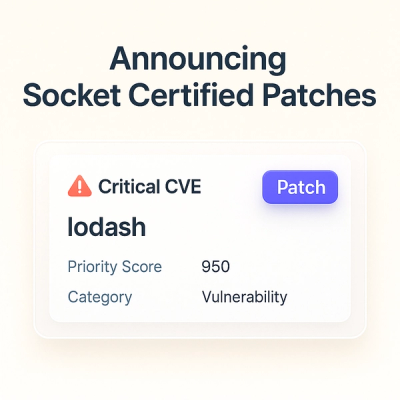
Product
Introducing Socket Scanning for OpenVSX Extensions
Socket now scans OpenVSX extensions, giving teams early detection of risky behaviors, hidden capabilities, and supply chain threats in developer tools.
onetable-cli
Advanced tools

One Table to Rule Them All
The DynamoDB OneTable Migration CLI is a command line tool for orchestrating DynamoDB migrations when using DynamoDB OneTable and OneTable Migrate.
The CLI is ideal for development teams to initialize and reset database contents and for production use to control and sequence step-wise database upgrades, downgrades and maintenance tasks. It is a vital tool to successfully evolve your Single-Table DynamoDB patterns.
The OneTable CLI was used in production by the SenseDeep Developer Studio for all DynamoDB access for a year before it was published as an NPM module.
npm i onetable-cli -g
OneTable migrations can be executed locally for simple tasks, however it is best to host your migrations close to the DynamoDB table for maximum performance. When executing locally, the migration scripts reside on your local computer and DynamoDB operations are performed from your system. When executing remotely, the migration scripts reside in your AWS account region and DynamoDB operations are performed there, in close proximity to the DynamoDB table.
The OneTable CLI uses the OneTable Migrate controller library internally to manage migrations and you should generally host migrations and execute in the same AWS region and availability zone as your DynamoDB table. This will accelerate migrations by minimizing the I/O transfer time.
The easiest way to remotely host the OneTable Migrate library is by deploying the OneTable Controller which is a complete solution for remotely hosting the migrate library.
See OneTable Controller and OneTable Migrate for more details about Lambda hosting of the OneTable Migrate library.
To get started using local migrations without the OneTable Controller, create a directory for your migrations in your project.
mkdir ./migrations
Then create a migrate.json5 with your DynamoDB OneTable configuration. We use JSON5 so you can use Javascript object literal syntax.
{
onetable: {
name: 'your-dynamo-table',
// Other onetable configuration parameters.
partial: true,
},
dir: './migrations'
}
Set the name property to the name of your DynamoDB table and set the dir property to point to the directory containing the migrations.
You pass your OneTable configuration via the onetable collection. Ensure your crypto, nulls and typeField settings match your deployed code. If you have these set to non-default settings in your code, add them to your migrate.json5 onetable map to match.
Generate a stub migration
Migrations are Javascript files that export the methods up and down to apply the migration and a description property. The migration must nominate a version and provide the OneTable schema that applies for the table data at this version level.
onetable generate migration
This will create a 0.0.1.js migration that contains an up method to upgrade the database and a down method to downgrade to the previous version. Customize the up and down methods and description to suit.
For example:
import Schema from 'your-onetable-schema',
export default {
version: '0.0.1',
description: 'Purpose of this migration',
schema: Schema,
async up(db, migrate, params) {
if (!params.dry) {
// Code here to upgrade the database
} else {
console.log('Dry run: create "Model"')
}
},
async down(db, migrate, params) {
if (!params.dry) {
// Code here to downgrade the database to the prior version
} else {
console.log('Dry run: remove "Model"')
}
}
}
The db property is the OneTable Table instance. This migrate property is an instance of the CLI Migrate class.
Apply the next migration.
onetable up
Reverse the last migration.
onetable down
Repeat the last migration.
onetable repeat
Migrate to a specific version (up or down).
onetable 0.1.3
Run a specific named migration.
onetable cleanup-orphans
onetable reset
Apply all outstanding migrations.
onetable all
Show the last applied migration.
onetable status
Show applied migrations.
onetable list
Show outstanding migrations not yet applied.
onetable outstanding
Reset the database to the latest version. If you provide a reset.js migration, this migrations should reset the database to a known good state. The purpose of the reset migration is to have one migration that can quickly initialize a database with the latest data and schema without having to apply all historical migrations.
onetable reset
Generate a specific version migration.
onetable --bump 2.4.3 generate
# or generate with a bumped minor version number
onetable --bump minor generate
Do a dry run for a migration and not execute. This will set params.dry to true when invoking the up/down migration function. It is up to the up/down routines to implement the dry run functionality if that support is desired. During a dry run, the database migration table will not be updated nor will the current version and schema.
onetable --dry up
--aws-access-key # AWS access key
--aws-region # AWS service region
--aws-secret-key # AWS secret key
--bump [VERSION|major|minor|patch] # Version to generate or digit to bump
--config ./migrate.json5 # Migration configuration file
--crypto cipher:password # Crypto to use for encrypted attributes
--dir directory # Change to directory to execute
--dry # Dry-run, don't execute
--endpoint http://host:port # Database endpoint
--force # Force action without confirmation
--profile prod|qa|dev|... # Select configuration profile
--quiet # Run as quietly as possible
--table TableName # Set the DynamoDB table name
--version # Emit version number
You can configure access to your DynamoDB table in your AWS account several ways:
Via command line option:
onetable --aws-access-key key --aws-secret-key secret --aws-region us-east-1
Via migrate.json5:
{
aws: {
accessKeyId: 'your-key',
secretAccessKey: 'your-access',
region: 'us-east-1'
}
}
Or via environment variables:
export AWS_ACCESS_KEY_ID=your-access-key
export AWS_SECRET_ACCESS_KEY=your-secret-key
export AWS_DEFAULT_REGION=us-east-1
You can also use:
export AWS_PROFILE=aws-profile-name
export AWS_REGION=us-east-1
To access a local DynamoDB database, set the migrate.json5 aws.endpoint property to point to the listening endpoint.
{
aws: {
endpoint: 'http://localhost:8000'
}
}
To communicate with a Lambda hosting the OneTable Migrate Library, set the arn field to the ARN of your Lambda function. Then define your AWS credentials as described above to grant access for the CLI to your Lambda.
{
arn: 'arn:aws:lambda:us-east-1:123456789012:function:migrate-prod-invoke'
}
The ideal configuration for the CLI is to host the OneTable Migrate library in the same AWS region and availability zone as your DynamoDB table. This will accelerate migrations by minimizing the I/O transfer time.
To remotely host the OneTable Migrate library, deploy the OneTable Controller to your desired AWS account and region.
When deployed, configure migrations by setting the CLI migrate.json5 arn property to the ARN of your migration Lambda that hosts the Migration Library.
You can create a special named reset migration that is used for the onetable reset command which is is a quick way to get a development database up to the current version.
The reset migration should remove all data from the database and then initialize the database as required.
When creating your reset.js migration, be very careful when removing all items from the database. We typically protect this with a test against the deployment profile to ensure you never do this on a production database.
Sample reset.js migration:
import Schema from 'your-onetable-schema.js'
export default {
version: '0.0.1',
description: 'Database reset',
schema: Schema,
async up(db, migrate, params) {
// Careful not to remove all items on a production database!
if (migrate.params.profile == 'dev') {
await removeAllItems(db)
}
// Provision required database data
},
async down(db, migrate, params) {
if (migrate.params.profile == 'dev') {
await removeAllItems(db)
}
},
}
async function removeAllItems(db) {
do {
items = await db.scanItems({}, {limit: 100})
for (let item of items) {
await db.deleteItem(item)
}
} while (items.length)
}
You can use profiles in your migrate.json5 to have specific configuration for different build profiles.
Profiles are implemented by copying the properties from the relevant profile.NAME collection to the top level. For example:
Here is a sample migrate.json5 with profiles:
{
onetable: {
name: 'sensedb',
partial: true,
},
profiles: {
dev: {
dir: './migrations',
endpoint: 'http://localhost:8000'
},
qa: {
arn: 'arn:aws:lambda:us-east-1:xxxx:function:migrate-qa-invoke'
},
prod: {
arn: 'arn:aws:lambda:us-east-1:xxxx:function:migrate-prod-invoke'
}
}
}
If the profile is set to 'dev', the dev profile properties of dir, name, and endpoint are copied to the root level.
All feedback, contributions and bug reports are very welcome.
You can contact me (Michael O'Brien) on Twitter at: @SenseDeepCloud, or email and ready my Blog.
Please try our Serverless trouble shooter SenseDeep.
FAQs
DynamoDB OneTable CLI
We found that onetable-cli demonstrated a not healthy version release cadence and project activity because the last version was released a year ago. It has 1 open source maintainer collaborating on the project.
Did you know?

Socket for GitHub automatically highlights issues in each pull request and monitors the health of all your open source dependencies. Discover the contents of your packages and block harmful activity before you install or update your dependencies.

Product
Socket now scans OpenVSX extensions, giving teams early detection of risky behaviors, hidden capabilities, and supply chain threats in developer tools.

Product
Bringing supply chain security to the next generation of JavaScript package managers

Product
A safer, faster way to eliminate vulnerabilities without updating dependencies